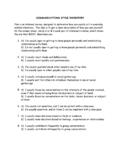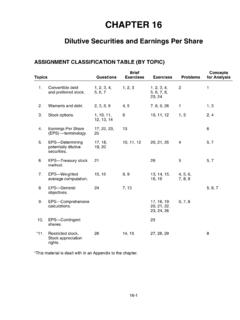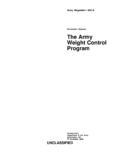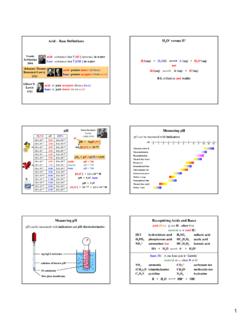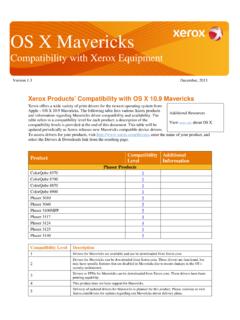Transcription of CHAPTER 10
1 10-1 CHAPTER 10 Acquisition and Dispositionof Property, Plant, and EquipmentASSIGNMENT CLASSIFICATION TABLE (BY TOPIC)TopicsQuestionsBriefExercisesExerc isesProblems Conceptsfor Analysis1. Valuation and classificationof land, buildings, , 2, 3, 4,6, 7, 12,13, 1811, 2, 3, 4,5, 131, 2, 3, 51, 6, 72. Self-constructed assets,capitalization of , 8, 20, 214, 6, 1223. Capitalization of , 9, 10,13, 182, 3, 44, 5, 7, 8,9, 10, 161, 5, 6, 73, 44. Exchanges of assets12, 16, 178, 9, 10,11, 123, 11, 16,17, 18, 19,204, 8, 9,10, 1155. Lump-sum purchases,issuance of stock, deferredpayment , 14, 156, 73, 6, 11,12, 13, 14,15, 161, 116. Costs subsequent , 18,19, 221321, 22, 2317. Alternative Disposition of , 1524, 254110-2 ASSIGNMENT CLASSIFICATION TABLE (BY LEARNING OBJECTIVE)
2 Learning Objectives property, plant, and the costs to include in initial valuationof property, plant, and , 2, 3, 4, 5,11, 12, 131, 2, 3, 4,5, 6, the accounting problems associatedwith self-constructed , 5, 6,11, the accounting problems associatedwith interest , 3, 45, 6, 7, 8,9, 105, 6, 7, 8, 9,10, the accounting issues relatedto acquiring and valuing plant , 6, 7, 8, 9,10, 11, 1211, 12, 13, 14,15, 16, 17, 18,19, 203, the accounting treatment for costssubsequent to , 22, 23, the accounting treatment for thedisposal of property, plant, and , 15252, 4, 1110-3 ASSIGNMENT CHARACTERISTICS TABLEItemDescriptionLevel ofDifficultyTime(minutes) E10-1 Acquisition costs of 20 E10-2 Acquisition costs of 15 E10-3 Acquisition costs of 15 E10-4 Purchase and self-constructed cost of 25 E10-5 Treatment of various 40 E10-6 Correction of improper cost 20 E10-7 Capitalization of 25 E10-8 Capitalization of 25 E10-9 Capitalization of 25 E10-10 Capitalization of 25 E10-11 Entries for equipment 15 E10-12 Entries for asset acquisition.
3 Including 20 E10-13 Entries for acquisition of 25 E10-14 Purchase of equipment with zero-interest-bearing 20 E10-15 Purchase of computer with zero-interest-bearing 20 E10-16 Asset 35 E10-17 Nonmonetary 15 E10-18 Nonmonetary 25 E10-19 Nonmonetary 20 E10-20 Nonmonetary 20 E10-21 Analysis of subsequent 25 E10-22 Analysis of subsequent 20 E10-23 Analysis of subsequent 25 E10-24 Entries for disposition of 25 E10-25 Disposition of 20 P10-1 Classification of acquisition and other asset 40 P10-2 Classification of acquisition 55 P10-3 Classification of land and building 45 P10-4 Dispositions, including condemnation, demolition, 40 P10-5 Classification of costs and interest 30 P10-6 Interest during 35 P10-7 Capitalization of interest, 30 P10-8 Nonmonetary 45 P10-9 Nonmonetary 40 P10-10 Nonmonetary 40 P10-11 Purchases by deferred payment, lump-sum, andnonmonetary 45 CA10-1 Acquisition, improvements, and sale of 25 CA10-2 Accounting for self-constructed 2510-4 ASSIGNMENT CHARACTERISTICS TABLE (Continued)ItemDescriptionLevel ofDifficultyTime(minutes)CA10-3 Capitalization of 25CA10-4 Capitalization of 40CA10-5 Nonmonetary 40CA10-6 Costs of 25CA10-7 Cost of land versus buildings 2510-5 ANSWERS TO QUESTIONS1.
4 The major characteristics of plant assets are (1) that they are acquired for use in operations andnot for resale, (2) that they are long-term in nature and usually subject to depreciation, and (3) thatthey have physical The company should report the asset at its historical cost of $420,000, not its current value. Themain reasons for this position are (1) at the date of acquisition, cost reflects fair value; (2) historicalcost involves actual, not hypothetical transactions, and as a result is extremely reliable; and(3) gains and losses should not be anticipated but should be recognized when the asset is (a) The acquisition costs of land may include the purchase or contract price, the broker scommission, title search and recording fees, assumed taxes or other liabilities, and surveying,demolition (less salvage), and landscaping costs.
5 (b) Machinery and equipment costs may properly include freight and drayage (handling), taxes onpurchase, insurance in transit, installation, and expenses of testing and breaking-in.(c) If a building is purchased, all repair charges, alterations, and improvements necessary to readythe building for its intended use should be included as a part of the acquisition cost. Buildingcosts in addition to the amount paid to a contractor may include excavation, permits andlicenses, architect s fees, interest accrued on funds obtained for construction purposes (duringconstruction period only) called avoidable interest, insurance premiums applicable to theconstruction period, temporary buildings and structures, and property taxes levied on thebuilding during the construction (a) Land.
6 (b) Land.(c) Land.(d) Machinery. The only controversy centers on whether fixed overhead should be allocated as acost to the machinery.(e) Land Improvements, may be depreciated.(f) Building.(g) Building, provided the benefits in terms of information justify the additional cost involved inproviding the information (FASB Statement No. 34).(h) Land.(i) (a) The position that no fixed overhead should be capitalized assumes that the construction ofplant (fixed) assets will be timed so as not to interfere with normal operations. If this were notthe case, the savings anticipated by constructing instead of purchasing plant assets would benullified by reduced profits on the product that could have been manufactured and sold. Thus,construction of plant assets during periods of low activity will have a minimal effect on the totalamount of overhead costs.
7 To capitalize a portion of fixed overhead as an element of the costof constructed assets would, under these circumstances, reduce the amount assignable tooperations and therefore overstate net income in the construction period and understate netincome in subsequent periods because of increased depreciation charges.(b) Capitalizing overhead at the same rate as is charged to normal operations is defended bythose who believe that all manufacturing overhead serves a dual purpose during plant assetconstruction periods. Any attempt to assign construction activities less overhead than thenormal rate implies costing favors and results in the misstatement of the cost of both plantassets and finished CHAPTER 10 (Continued)6.
8 (a) Disagree. Organization and promotion expenses should be expensed.(b) Agree. Architect s fees for plans actually used in construction of the building should be chargedto the building account as part of the cost.(c) Agree. FASB Statement No. 34 recommends that avoidable interest or actual interest cost,whichever is lower, be capitalized as part of the cost of acquiring an asset if a significant periodof time is required to bring the asset to a condition or location necessary for its intended costs are capitalized starting with the first expenditure related to the asset andcapitalization would continue until the asset is substantially completed and ready for itsintended use. Property taxes during construction should also be charged to the buildingaccount.
9 (d) Disagree. Interest revenue is not considered to be related to the interest received as part of theacquisition cost of the Since the land for the plant site will be used in the operations of the firm, it is classified as property,plant, and equipment. The other tract is being held for speculation. It is classified as A common accounting justification is that all costs associated with the construction of an asset,including interest, should be capitalized in order that the costs can be matched to the revenueswhich the new asset will help Assets that do not qualify for interest capitalization are (1) assets that are in use or ready for theirintended use, and (2) assets that are not being used in the earnings activities of the The avoidable interest is determined by multiplying (an) interest rate(s) by the weighted-averageamount of accumulated expenditures on qualifying assets.
10 For the portion of weighted-averageaccumulated expenditures which is less than or equal to any amounts borrowed specifically tofinance construction of the assets, the capitalization rate is the specific interest rate incurred. Forthe portion of weighted-average accumulated expenditures which is greater than specific debtincurred, the interest rate is a weighted average of all other interest rates amount of interest to be capitalized is the avoidable interest, or the actual interest incurred,whichever is indicated in the CHAPTER , an alternative to the specific rate is to use an average borrowing The total interest cost incurred during the period should be disclosed, indicating the portioncapitalized and the portion charged to revenue from temporarily invested excess funds should not be offset against interest costwhen determining the amount of interest to be capitalized.
